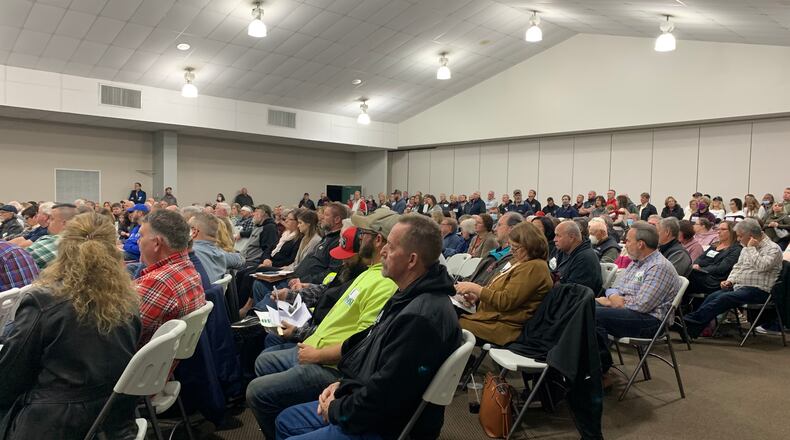Commissioners approved the designation for Xenia Twp. and Sugarcreek Twp. during their regular meeting Thursday, and will consider the smaller Ross Twp.’s request on Feb. 24. Cedarville Twp.’s request has already been approved.
The requests come on the heels of the Ohio Power Siting Board striking down an application by Kingwood Solar to place solar panels on roughly 1,200 acres (just shy of two square miles) between Yellow Springs and Cedarville, citing “overwhelming” public backlash and the opposition of all four local governments (Xenia, Miami, and Cedarville Twps., as well as the county commission) involved in the project.
Owned by Texas-based Vesper Energy, Kingwood had acquired long-term leases with private landowners to construct the 175-megawatt facility, and would have generated over $1.5 million in tax revenue for the county, according to the company. Kingwood has since appealed the decision.
Back in 2021, the county commissioners raised questions about the private property rights of the 17 landlords that leased their land to Kingwood. However, that topic has been less prevalent in recent public discussions on the solar issue.
The lengthy controversy has not only prompted local governments to appeal to the county commission, but for some to take a look at their own zoning laws. While large-scale solar utilities over 50 megawatts are governed by the Ohio Power Siting Board, those under 50 megawatts are governed by local zoning regulations.
Xenia Twp. has slowly rolled out changes to its zoning code that not only govern solar developments, but a wide range of uses, after township trustees found “a void” governing major commercial operations, said Xenia Twp. Administrator Alan Stock. Currently 89% of Xenia Twp. is in agricultural use, and the changes are intended to “preserve the scenic natural beauty of Xenia Township,” according to township documents.
“Say Amazon wants to come in and build a big warehouse. Or Walmart, or Lowe’s wants to bring in a big box store. Solar wants to come in with solar arrays. From that perspective, you would have to have a better buffer between the residents and these uses,” Stock said.
Trustees in January passed changes to zoning rules, creating “scenic overlay districts,” intended to protect roadways and waterways. Commercial operations would fall under “conditional use,” and would be subject to certain additional requirements, as well as annual fees and inspections, per the township’s zoning code.
Solar companies typically seek out farmland for industrial arrays, because of the generally flat land, proximity to the grid, and the large amount of sun they typically get, siting board officials previously told the Dayton Daily News. However, residents and local governments have pushed back at the idea of taking farmland out of agricultural use, saying there are other locations that would be better for solar farms.
In Greene County, there are existing brownfields, including sites near Wright-Patterson Air Force Base, that would be better suited to solar development, officials said.
“We’re going ‘Hey, there’s a couple of brownfields here. That’d be a great place to put them.’ Putting panels on top of hospitals, putting it over other companies’ parking,” Stock said. “We are not against solar, but we are for responsible solar. Responsible solar is not taking land out of production from feeding us.”
Though Sugarcreek Twp. was not part of any large-scale solar utility request, trustees requested protections because of the high number of residential subdivisions in the community, Sugarcreek Twp. Administrator Barry Tiffany said.
“It’s just the fit,” Tiffany said. “We’re a residential community with open spaces, and we’ve worked hard to retain those open spaces and that rural character.”
Sugarcreek’s zoning rules allow solar panels on private property, as long as they’re not in the owner’s front yard. However, many neighborhoods and homeowners’ associations there have stricter rules in their covenants and restrictions, Tiffany said.
“You’re probably going to see more people doing that,” he added.
About the Author

